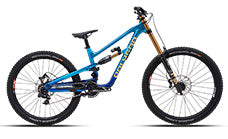Fox vs. Rock Shox: An In-depth Comparison of Mountain Bike Suspension Leaders

Fox and Rock Shox: In the thrilling realm of mountain biking, the quality of your suspension can significantly impact your ride. Among the leading brands, Fox and Rock Shox are prominent for their superior products, innovative technologies, and support of top-tier athletes. This detailed comparison explores the histories, product ranges, and technical advancements of these two industry giants. Whether you’re a beginner making your first significant purchase or an experienced rider considering an upgrade, this article will guide you through making an informed choice. Let’s dive into the ultimate showdown between Fox and Rock Shox!
Fox and Rock Shox
have established themselves as formidable forces in the mountain biking world. Celebrated for their dedication to innovation, quality, and rider satisfaction, these brands offer some of the best suspensions in the market. Fox, also known as Fox Racing Shox, entered the mountain biking scene in 1993, although its origins date back to 1974. Famous for its precision engineering and revolutionary technologies such as the Kashima coating and live valve electronic suspension, Fox has consistently led in suspension technology.
Conversely, Rock Shox, founded in 1989, quickly made its mark by introducing the first production suspension fork. With a pioneering approach, Rock Shox has continuously innovated, offering a range of dependable, high-performance products. Ongoing updates and a commitment to rider feedback have kept Rock Shox a top contender in mountain bike suspension technology.
Historical Background and Brand Evolution
The rich histories of Fox and Rock Shox play a crucial role in their current reputations. Fox originated in 1974 with a focus on enhancing the suspension systems for motocross bikes and smoothly transitioned into mountain biking as the sport gained popularity in 1993. The brand swiftly earned acclaim for its high-quality products and uncompromising performance standards.
Rock Shox made a significant impact in 1989, aiming to transform mountain biking with the debut of its first production suspension fork. This innovation redefined mountain biking's dynamics, making the sport more accessible and enjoyable. Over the decades, Rock Shox has broadened its product offerings and continued to push technological boundaries.
This competition between the two brands has spurred numerous innovations and set high industry benchmarks, enhancing the mountain biking experience for all riders.
Product Lineup Comparison
Both Fox and Rock Shox boast extensive product lineups catering to different biking disciplines. Fox uses straightforward nomenclature for its forks, such as the 32, 34, 36, 38, and 40 series, indicating the upper tube diameter with larger numbers suited for more robust applications, from cross-country (XC) to downhill (DH).
Rock Shox features a more intricate naming system with models like Sid, Pike, Lyrik, Zeb, and Boxxer, addressing a broad range of requirements from XC to DH. Each brand offers various quality and performance levels to attract a wide audience, from budget-conscious enthusiasts to professional athletes. Whether seeking affordability or top-tier performance, both brands provide options to suit your needs.
Internal Technologies and Performance: The core technologies within suspension forks significantly influence their performance, and both Fox and Rock Shox invest heavily in this area. Fox’s lineup includes advanced dampers like the Grip X2, Grip X, and Grip SL, offering different adjustment levels suited for varying terrains. These features ensure that Fox forks provide a more dynamic and precise ride, enhancing bike handling and rider connection to the trail.
Rock Shox’s Charger 3.1 damper, a rival to Fox’s technology, offers comparable adjustability and fine-tuning, allowing riders to tailor their performance according to specific requirements. This focus on enhancing airtime, bump absorption, and overall control underlines Rock Shox’s commitment to delivering a thrilling and smooth riding experience.
In the realm of internal technologies, both brands continuously strive to innovate, making the choice between them a matter of personal preference and intended riding conditions.
Rider Experience and Preference: Rider experience heavily depends on individual preferences. Fox forks are often lauded for their sportier and more precise feel, providing better handling and connection, crucial for navigating technical terrains. Conversely, Rock Shox forks are known for their softer, more forgiving nature, especially at the start of the trip, offering a more comfortable ride in certain conditions.
Weight also plays a significant role in rider preference. Fox products tend to be lighter, which can be advantageous during extended rides or uphill sections. However, the ultimate choice typically boils down to personal comfort and riding style, with some riders preferring precision and responsiveness, while others favour a more cushioned, forgiving ride.
Rear Suspension: Air vs. Coil Shocks
The comparison extends beyond front suspension forks to include rear shocks, which are vital for a bike’s overall performance. Fox’s range features both air shocks, like the Float series, and coil shocks for more demanding applications. Air shocks are generally lighter and offer easier adjustability, making them popular among XC and trail riders. Meanwhile, coil shocks provide consistent performance and superior small-bump sensitivity, making them suitable for downhill and Enduro applications.
Rock Shox also offers a diverse range of rear shocks, ensuring options for every rider’s needs. The brand’s air shocks are known for their reliability and ease of adjustability, while its coil shocks deliver robust performance and excellent bump absorption.
The choice between air and coil shocks ultimately hinges on the rider’s terrain and preferences. Air shocks are ideal for those prioritizing weight savings and adjustability, whereas coil shocks are preferred by riders seeking durability and smooth performance on rough trails.
Final Thoughts
Personal Preference and Riding Style: The debate between Fox and Rock Shox may never be conclusively settled as both brands offer outstanding products, with the final decision often resting on personal preference and riding style. Fox is typically favoured by those seeking precision and a sportier feel, while Rock Shox might appeal to riders who prefer a softer, more forgiving experience.
Understanding your specific needs and expectations is crucial in choosing the right suspension. Whether you are an XC enthusiast, trail rider, or dedicated downhill racer, both Fox and Rock Shox have options that can enhance your riding experience. It's beneficial to test various models when possible and consider your terrain and riding style. The best suspension is ultimately the one that provides confidence and comfort on the trail.
In the dynamic world of mountain biking, selecting the appropriate suspension can transform your rides, making them more enjoyable and rewarding. Happy trails!
















































































